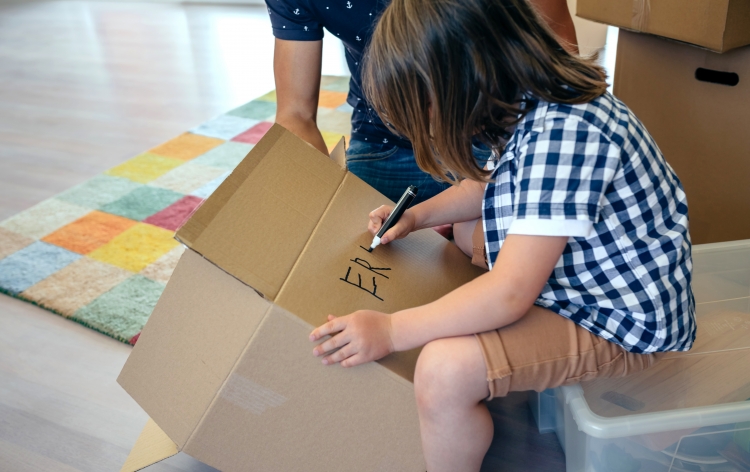Staying organized during your move can save you time, money, and headaches. One surefire way to maintain organization throughout your move is a structured labeling system. You need quality tools, a fool-proof labeling plan, and good communication with your movers to make sure your strategy works.
There are two basic labeling systems to use to organize your boxes: Colors and numbers
Color-coding moving boxes
Moving boxes typically sport traditional clear packing tape, but why not change it up with some color? Pick a different color tape for each of the rooms in your new house to keep you and your movers organized.
It’s a pretty simple idea. Pack all of your kitchen goods into boxes and tape them shut with blue tape. Pack all of your bedroom supplies into boxes and tape them shut with red tape. You get the picture. When the boxes arrive at your new house, you and your movers will know where the boxes go.
If you don’t have colored tape, get colored stickers or some colored markers. You can use the same concept by labeling all of your kitchen boxes with a blue marker or sticker and all of your bedroom boxes with red.
To keep everyone on the same page, tape pieces of colored paper on the doors or walls of your new home matching the already color-coded boxes. A piece of red paper taped to the bedroom door makes it clear to everyone moving that red-coded boxes belong in the red-coded room. Writing the names of the rooms on the boxes, even if you’re using colored tape, will help.
Numbering moving boxes
While color-coding boxes will brighten up your moving experience, a basic numbering system also works well. Give each box a specific number. Place that unique number and room on three sides of the box. Then create a master inventory list. The inventory list should include the box number, the room, and the contents of that specific box.
For example, place your blender and coffee maker in a box. Label the box, “1 Kitchen”, and then on your master inventory list write blender and coffee maker under the contents section for box #1. This system will tell your movers where to move specific boxes and will tell you what is in those boxes. Make sure you save the master inventory list in multiple locations so you don’t risk losing it completely.
Alternatively, to ensure you have all your boxes, number them sequentially by room. For example, if you have 15 boxes in your kitchen, label them “Kitchen 1/15”, “Kitchen 2/15”, “Kitchen 3/15”, etc. When you unload the truck, you should have 15 boxes in your kitchen. If you’re missing a box, you will know quickly which box is missing and which room it’s missing from.
Here are 4 tips to remember no matter which labeling system you use
 1. Quality markers
1. Quality markers
Quality markers will make a big difference. You could grab a marker from the mug on your desk, but investing in new, high-quality markers will ensure the writing on your boxes is clear and easy to read. You want markers that will work well all the way through labeling the last of your boxes. If your markers start to get dull before the end, it will make your labels difficult to read.
2. Fragile labels
Indicate fragile boxes clearly with bold labels. Movers will be careful with all of your boxes, but by pointing out the delicate nature of specific boxes, they will take extra care.
3. Don’t wait
Do not wait to label or inventory your boxes. As soon as you pack the box, label it so that you don’t have to go back later and try to remember what was in each box.
4. Remove previous markings
If you choose to use recycled boxes, tape your new labels or blank pieces of paper over the previous labels to prevent confusion.


